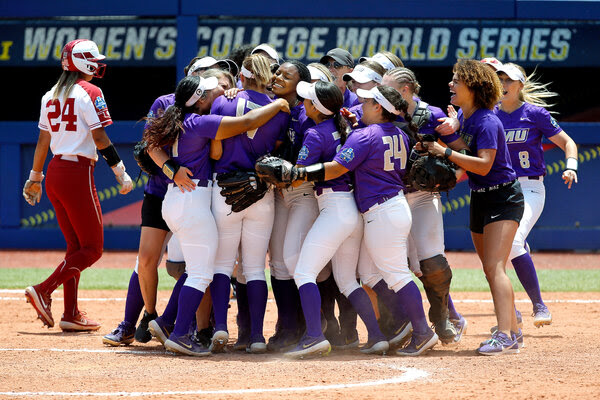Glad to see the media continue to shine a light on how differently the NCAA treats women's and men's championships. This article is interesting because it highlights how close in popularity (tv ratings, attendance, etc) the softball CWS is to the baseball CWS....which is the defenders favorite argument. Hard not to see that the way the NCAA treats this is actually stunting the possible growth in popularity of women's college sports. I hope our coaches (mens and womens and the AD) continue to speak out on this. NCAA talks a good game here, but simply does not walk the walk.
Good morning. With a popular softball tournament underway, we look at the differences between men’s and women’s college sports. |
|
Massages vs. doubleheaders |
The Women’s College World Series, which began yesterday, is one of the most popular events in college sports. |
It is an eight-team softball tournament held every year in Oklahoma City, and the games frequently sell out. The television audience on ESPN is substantial, too. In the most recent previous tournament, 1.8 million people watched the final game, substantially more than have watched recent championship games of college soccer, hockey or lacrosse — men’s or women’s. |
The popularity of softball makes it a telling study in the different ways that the N.C.A.A. treats female and male athletes. In terms of fan interest, softball ranks near the top of college sports. It is well behind football and basketball, but ahead of almost every other sport. |
Yet the N.C.A.A. treats softball as a second-class sport, many athletes and coaches say. |
The stadium that hosts the championship tournament has no showers; players and coaches must instead shower at their hotels. Off days between games are rare, and some teams have to play twice on the same day, increasing injury risk. The N.C.A.A. prefers the condensed schedule to hold down hotel and meal costs, coaches have told Jenni Carlson of The Oklahoman. |
The men’s version of the College World Series — an eight-team baseball tournament held each year in Omaha — treats the players better. They have off days, as well as a golf outing, a free massage day and a celebratory dinner for coaches, players and dozens of guests, Molly Hensley-Clancy of The Washington Post reported. |
The Oklahoma City softball stadium is also too small to hold all the fans who would like to attend, and many games sell out quickly. It has a capacity of about 13,000 (recently expanded from 9,000), compared with 24,000 for the baseball stadium in Omaha. “I think we could easily get 20,000, just like the men,” one longtime coach told The Post. “But we won’t get that chance.” |
Similar ratings, different treatment |
Gender equality in sports has been the subject of growing debate in recent years, partly because of protests from the U.S. women’s soccer team over its treatment. The new attention on college sports was prompted by a video that Sedona Prince, a University of Oregon basketball star, posted on social media in March. In it, she contrasted the sprawling weight room for the men’s tournament with a single small rack of weights for the women’s tournament. |
“If you’re aren’t upset about this problem, then you are a part of it,” she said. (Gillian Brassil has profiled Prince in The Times, focusing on her recovery from a life-threatening leg injury.) |
The video received tens of millions of views and led athletes, coaches and parents in other sports to scrutinize other college tournaments, Alan Blinder, a Times sports reporter, told me. “It’s an issue that has wide resonance on social media, where student-athletes can make their views and experiences known without as much interference from a university gatekeeper,” Alan said. Women’s volleyball players, for example, documented that their practice court consisted of a mat atop a cement floor. |
Equity in sports can be a complicated topic, because men’s sports often draw larger crowds and television audiences. Officials who defend the differential treatment of female and male athletes — as executives at U.S. Soccer have — cite the revenue differences. |
But the softball situation shows how incomplete those explanations are. The average television audience for the most recent softball World Series (1.05 million) was similar to that of the most recent college baseball World Series (1.13 million). And yet one sport’s players get showers, off days, massages and a festive dinner, while the others get doubleheaders and sweaty bus rides back to a hotel. |
Jacquie Joseph, the longtime softball coach at Michigan State, has said that softball players are treated worse than women’s basketball players, who are in turn treated worse than men’s basketball players. “They’re the chosen ones,” Joseph said, referring to women’s basketball teams, “and they’re treated like afterthoughts. What’s lower than an afterthought? That’s us.” |
I asked N.C.A.A. officials for a response, and they did not address any of the specific differences between the baseball and softball tournaments. In an emailed statement, Joni Comstock, the senior vice president of championships, said the N.C.A.A. was looking forward to “another exciting championship series.” |
In yesterday’s opening game, James Madison — appearing in its first World Series — upset top-seeded Oklahoma, 4-3. Today, James Madison plays Oklahoma State, and Alabama plays U.C.L.A. |
For more: |
|



